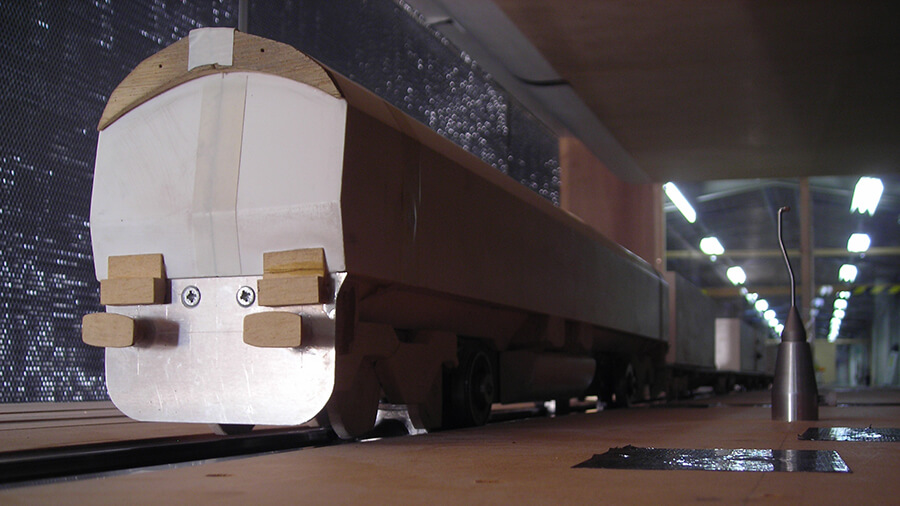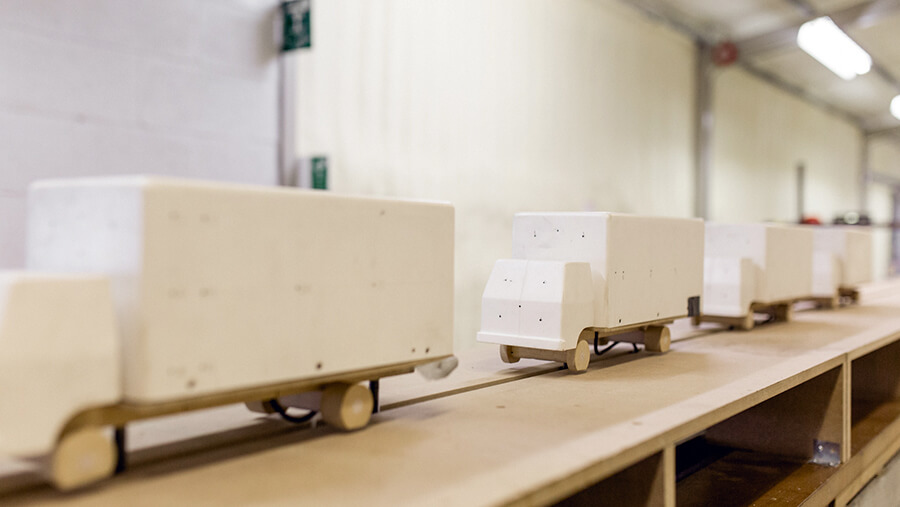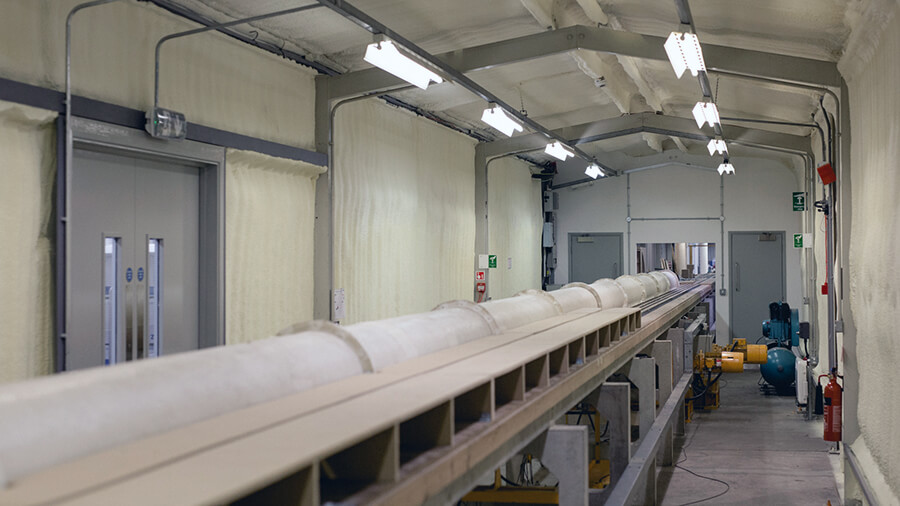The Transient Aerodynamic Investigation (TRAIN) rig is a purpose built facility for measuring the aerodynamics of scale moving model vehicles. The unique facility offers the flexibility to conduct a range of experiments crucial to a detailed understanding of vehicle aerodynamic flows. These include, but are not limited to:
- Slipstream velocity measurements
- Static pressure pulse measurements
- Pressures acting on the train using bespoke on-board data loggers
- The effects of crosswinds at various yaw angles
- Aerodynamic pressures acting on trackside structures
- Aerodynamic effects of a train passing through a tunnel and sonic booms
- The effects of embankments on train aerodynamics
- The aerodynamic effects due to train design and size
- Aerodynamic loads affecting ballast flight
- Pollutant dispersion
 The large 150 m long facility is essentially a catapult along which, nominally 1/10th-1/25th, scale models can be fired at speeds up to 80 m/s. Additional capabilities includes modelling the interaction of passing vehicles. The advantages of using a moving model rig over a traditional wind tunnel for measuring vehicle aerodynamics is the ability to correctly model the relative motion between the moving vehicle and the static ground.
The large 150 m long facility is essentially a catapult along which, nominally 1/10th-1/25th, scale models can be fired at speeds up to 80 m/s. Additional capabilities includes modelling the interaction of passing vehicles. The advantages of using a moving model rig over a traditional wind tunnel for measuring vehicle aerodynamics is the ability to correctly model the relative motion between the moving vehicle and the static ground.
The TRAIN rig has recently undergone a large £1.5 million renovation as part of the UK Collaboratorium for Research in Infrastructure and Cities (UKCRIC) project. The vision of the UKCRIC is to create, operate and coordinate an (inter)national multi-disciplinary research programme in a partnership between Industry, Government and Academia. The Government has provided £138 million of funding for UK national and local infrastructure (such as transport, water, waste, energy and ICT systems) to be fit for purpose for supporting societal development in a changing world. The project is coordinated by thirteen partners, representing the major university-based infrastructure, civil and construction engineering research groups in the UK.
 The renovation works at the TRAIN rig have been coordinated in three key strands – building extension works, developing the crosswind tunnel and increasing instrumentation capabilities. A large 45 m extension has been built onto the side of the existing TRAIN rig to allow the crosswind tunnel capabilities to be increased through the creation of a 7 m wide space spanning over 15 m of running track. The new 30 fan return flow crosswind tunnel built into this space offers the capability of a much larger flow fetch and greater flexibility to control the flow characteristics before the running tracks. The extension has also created a much needed new workshop facility. In addition to the main building extension, the main test hall has been separated with walls from the firing and brake zone and the whole space insulated to allow greater climate control in the test hall.
The renovation works at the TRAIN rig have been coordinated in three key strands – building extension works, developing the crosswind tunnel and increasing instrumentation capabilities. A large 45 m extension has been built onto the side of the existing TRAIN rig to allow the crosswind tunnel capabilities to be increased through the creation of a 7 m wide space spanning over 15 m of running track. The new 30 fan return flow crosswind tunnel built into this space offers the capability of a much larger flow fetch and greater flexibility to control the flow characteristics before the running tracks. The extension has also created a much needed new workshop facility. In addition to the main building extension, the main test hall has been separated with walls from the firing and brake zone and the whole space insulated to allow greater climate control in the test hall.
A large part of the UKCRIC upgrades was to increase the scientific instrumentation capabilities. Firstly, the firing mechanisms for all firing tracks have been overhauled allowing for greater ease of use and the ability to fire vehicles in both directions. Major equipment purchases include a LaVision 3-D tomographic volumetric PIV system, capable of measuring flow volumes of 0.5m3, a 48 channel triple wire system and 18 multi-hole pressure probes capable of measuring velocities in 3 dimensions and static pressure. The renovation work has also focused on productivity and ease of use in the facility, which has led to a bespoke designed ‘plug and play’ system to measure pressure making use of the increased number of pressure transducers.
 If you have any questions about the use of the facility, any research ideas or work you would like to commission in the facility, please contact Dr David Soper.
If you have any questions about the use of the facility, any research ideas or work you would like to commission in the facility, please contact Dr David Soper.